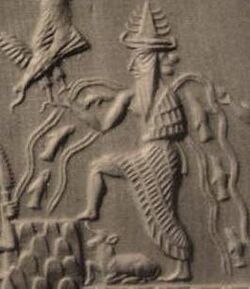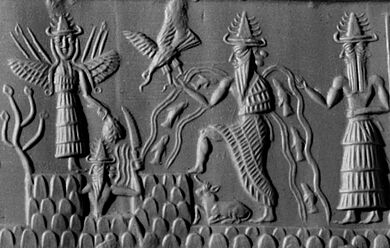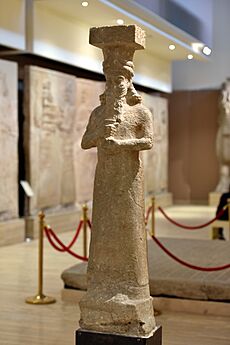Enki facts for kids
Quick facts for kids Enki𒀭𒂗𒆠 |
|
|---|---|
| God of creation, intelligence, crafts, fertility, magic, mischief | |

Detail of Enki from the Adda Seal, an ancient Akkadian cylinder seal dating to circa 2,300 BC
|
|
| Symbol | Goat, fish, goat-fish, chimera |
| Personal information | |
| Consort | Ninhursag, Damkina |
| Children | Marduk, Dumuzid, Ninsar, Ninkurra, Uttu, Ninti |
| Parents | An and Nammu |
| Siblings | Enlil |
| Equivalents | |
| Greek equivalent | Poseidon, Prometheus |
| Egyptian equivalent | Ptah |
Enki (Sumerian: 𒀭𒂗𒆠 DEN-KI) is the Sumerian god of water, knowledge (gestú), crafts (gašam), and creation (nudimmud), and one of the Anunnaki. He was later known as Ea (Akkadian: 𒀭𒂍𒀀) or Ae in Akkadian (Assyrian-Babylonian) religion, and is identified by some scholars with Ia in Canaanite religion. The name was rendered Aos in Greek sources (e.g. Damascius).
He was originally the patron god of the city of Eridu, but later the influence of his cult spread throughout Mesopotamia and to the Canaanites, Hittites and Hurrians. He was associated with the southern band of constellations called stars of Ea, but also with the constellation AŠ-IKU, the Field (Square of Pegasus). Beginning around the second millennium BCE, he was sometimes referred to in writing by the numeric ideogram for "40", occasionally referred to as his "sacred number". The planet Mercury, associated with Babylonian Nabu (the son of Marduk) was, in Sumerian times, identified with Enki, as was the star Canopus.
Many myths about Enki have been collected from various sites, stretching from Southern Iraq to the Levantine coast. He is mentioned in the earliest extant cuneiform inscriptions throughout the region and was prominent from the third millennium down to the Hellenistic period.
Etymology
The exact meaning of Enki's name is uncertain: the common translation is "Lord of the Earth". The Sumerian En is translated as a title equivalent to "lord" and was originally a title given to the High Priest. Ki means "earth", but there are theories that ki in this name has another origin, possibly kig of unknown meaning, or kur meaning "mound". The name Ea is allegedly Hurrian in origin while others claim that his name 'Ea' is possibly of Semitic origin and may be a derivation from the West-Semitic root *hyy meaning "life" in this case used for "spring", "running water". In Sumerian E-A means "the house of water", and it has been suggested that this was originally the name for the shrine to the god at Eridu.
It has also been suggested that the original non-anthropomorphic divinity at Eridu was not Enki but Abzu. The emergence of Enki as the divine lover of Ninhursag, and the divine battle between the younger Igigi divinities and Abzu, saw the Abzu, the underground waters of the Aquifer, becoming the place in which the foundations of the temple were built. With some Sumerian deity names as Enlil there are variations like Elil. En means "Lord" and E means "temple". It is likely that E-A is the Sumerian short form for "Lord of Water", as Enki is a god of water. Ab in Abzu also means water.
Worship
The main temple to Enki was called E-abzu, meaning "abzu temple" (also E-en-gur-a, meaning "house of the subterranean waters"), a ziggurat temple surrounded by Euphratean marshlands near the ancient Persian Gulf coastline at Eridu. It was the first temple known to have been built in Southern Iraq. Four separate excavations at the site of Eridu have demonstrated the existence of a shrine dating back to the earliest Ubaid period, more than 6,500 years ago. Over the following 4,500 years, the temple was expanded 18 times, until it was abandoned during the Persian period. On this basis Thorkild Jacobsen has hypothesized that the original deity of the temple was Abzu, with his attributes later being taken by Enki over time. P. Steinkeller believes that, during the earliest period, Enki had a subordinate position to a goddess (possibly Ninhursag), taking the role of divine consort or high priest, later taking priority. The Enki temple had at its entrance a pool of fresh water, and excavation has found numerous carp bones, suggesting collective feasts. Carp are shown in the twin water flows running into the later God Enki, suggesting continuity of these features over a very long period. These features were found at all subsequent Sumerian temples, suggesting that this temple established the pattern for all subsequent Sumerian temples. "All rules laid down at Eridu were faithfully observed".
Iconography
Enki was the keeper of the divine powers called Me, the gifts of civilization. He is often shown with the horned crown of divinity.
On the Adda Seal, Enki is depicted with two streams of water flowing into each of his shoulders: one the Tigris, the other the Euphrates. Alongside him are two trees, symbolizing the male and female aspects of nature. He is shown wearing a flounced skirt and a cone-shaped hat. An eagle descends from above to land upon his outstretched right arm. This portrayal reflects Enki's role as the god of water, life, and replenishment.
Considered the master shaper of the world, god of wisdom and of all magic, Enki was characterized as the lord of the Abzu (Apsu in Akkadian), the freshwater sea or groundwater located within the earth. In the later Babylonian epic Enûma Eliš, Abzu, the "begetter of the gods", is inert and sleepy but finds his peace disturbed by the younger gods, so sets out to destroy them. His grandson Enki, chosen to represent the younger gods, puts a spell on Abzu "casting him into a deep sleep", thereby confining him deep underground. Enki subsequently sets up his home "in the depths of the Abzu." Enki thus takes on all of the functions of the Abzu, including his fertilising powers as lord of the waters.
Early royal inscriptions from the third millennium BCE mention "the reeds of Enki". Reeds were an important local building material, used for baskets and containers, and collected outside the city walls, where the dead or sick were often carried. This links Enki to the Kur or underworld of Sumerian mythology. In another even older tradition, Nammu, the goddess of the primeval creative matter and the mother-goddess portrayed as having "given birth to the great gods," was the mother of Enki, and as the watery creative force, was said to preexist Ea-Enki.

Influence
Enki and later Ea were apparently depicted, sometimes, as a man covered with the skin of a fish, and this representation, as likewise the name of his temple E-apsu, "house of the watery deep", points decidedly to his original character as a god of the waters (see Oannes). Around the excavation of the 18 shrines found on the spot, thousands of carp bones were found, consumed possibly in feasts to the god. Of his cult at Eridu, which goes back to the oldest period of Mesopotamian history, nothing definite is known except that his temple was also associated with Ninhursag's temple which was called Esaggila, "the lofty head house" (E, house, sag, head, ila, high; or Akkadian goddess = Ila), a name shared with Marduk's temple in Babylon, pointing to a staged tower or ziggurat (as with the temple of Enlil at Nippur, which was known as E-kur (kur, hill)), and that incantations, involving ceremonial rites in which water as a sacred element played a prominent part, formed a feature of his worship. This seems also implicated in the epic of the hieros gamos or sacred marriage of Enki and Ninhursag (above), which seems an etiological myth of the fertilisation of the dry ground by the coming of irrigation water. The early inscriptions of Urukagina in fact go so far as to suggest that the divine pair, Enki and Ninki, were the progenitors of seven pairs of gods, including Enki as god of Eridu, Enlil of Nippur, and Su'en (or Sin) of Ur, and were themselves the children of An (sky, heaven) and Ki (earth). The pool of the Abzu at the front of his temple was adopted also at the temple to Nanna (Akkadian Sin) the Moon, at Ur, and spread from there throughout the Middle East. It is believed to remain today as the sacred pool at Mosques, or as the holy water font in Catholic or Eastern Orthodox churches.
Whether Eridu at one time also played an important political role in Sumerian affairs is not certain, though not improbable. At all events the prominence of "Ea" led, as in the case of Nippur, to the survival of Eridu as a sacred city, long after it had ceased to have any significance as a political center. Myths in which Ea figures prominently have been found in Assurbanipal's library, and in the Hattusas archive in Hittite Anatolia. As Ea, Enki had a wide influence outside of Sumer, being equated with El (at Ugarit) and possibly Yah (at Ebla) in the Canaanite 'ilhm pantheon. He is also found in Hurrian and Hittite mythology as a god of contracts, and is particularly favourable to humankind. It has been suggested that etymologically the name Ea comes from the term *hyy (life), referring to Enki's waters as life-giving. Enki/Ea is essentially a god of civilization, wisdom, and culture. He was also the creator and protector of man, and of the world in general. Traces of this version of Ea appear in the Marduk epic celebrating the achievements of this god and the close connection between the Ea cult at Eridu and that of Marduk. The correlation between the two rises from two other important connections: (1) that the name of Marduk's sanctuary at Babylon bears the same name, Esaggila, as that of a temple in Eridu, and (2) that Marduk is generally termed the son of Ea, who derives his powers from the voluntary abdication of the father in favour of his son. Accordingly, the incantations originally composed for the Ea cult were re-edited by the priests of Babylon and adapted to the worship of Marduk, and, similarly, the hymns to Marduk betray traces of the transfer to Marduk of attributes which originally belonged to Ea.
It is, however, as the third figure in the triad (the two other members of which were Anu and Enlil) that Ea acquires his permanent place in the pantheon. To him was assigned the control of the watery element, and in this capacity he becomes the shar apsi; i.e. king of the Apsu or "the abyss". The Apsu was figured as the abyss of water beneath the earth, and since the gathering place of the dead, known as Aralu, was situated near the confines of the Apsu, he was also designated as En -Ki; i.e. "lord of that which is below", in contrast to Anu, who was the lord of the "above" or the heavens. The cult of Ea extended throughout Babylonia and Assyria. We find temples and shrines erected in his honour, e.g. at Nippur, Girsu, Ur, Babylon, Sippar, and Nineveh, and the numerous epithets given to him, as well as the various forms under which the god appears, alike bear witness to the popularity which he enjoyed from the earliest to the latest period of Babylonian-Assyrian history. The consort of Ea, known as Ninhursag, Ki, Uriash Damkina, "lady of that which is below", or Damgalnunna, "big lady of the waters", originally was fully equal with Ea, but in more patriarchal Assyrian and Neo-Babylonian times plays a part merely in association with her lord. Generally, however, Enki seems to be a reflection of pre-patriarchal times, in which relations between the sexes were characterised by a situation of greater gender equality. In his character, he prefers persuasion to conflict, which he seeks to avoid if possible.
Ea and West Semitic deities
In 1964, a team of Italian archaeologists under the direction of Paolo Matthiae of the University of Rome La Sapienza performed a series of excavations of material from the third-millennium BCE city of Ebla. Much of the written material found in these digs was later translated by Giovanni Pettinato. Among other conclusions, he found a tendency among the inhabitants of Ebla, after the reign of Sargon of Akkad, to replace the name of El, king of the gods of the Canaanite pantheon (found in names such as Mikael and Ishmael), with Ia (Mikaia, Ishmaia).
Jean Bottéro (1952) and others suggested that Ia in this case is a West Semitic (Canaanite) way of pronouncing the Akkadian name Ea. Scholars largely reject the theory identifying this Ia with the Israelite theonym YHWH, while explaining how it might have been misinterpreted. Ia has also been compared by William Hallo with the Ugaritic god Yamm ("Sea"), (also called Judge Nahar, or Judge River) whose earlier name in at least one ancient source was Yaw or Ya'a.
Ea was also known as Dagon and Uanna (Grecised Oannes), the first of the Seven Sages.
See also
- Ancient Near East
- Azazel
- Barbar Temple, a Dilmun-era temple in Bahrain devoted to the worship of Enki
- Capricorn (astrology)
- Capricornus
- Iah
- Jah
- Me (mythology)
- Mesopotamian mythology
- Ahura Mazda
- El (deity)




